For those using the Internet Explorer
Official support for the Internet Explorer has stopped.
Some contents of this page may be wrongly displayed.
To ensure full user satisfaction, please use a fully supported
browser.
(E.g. Chrome, Safari, Firefox, Opera, Edge)



The ductless heat exchange system "Seseragi®" constantly provides fresh air, maintaining a comfortable indoor environment. It also contributes to energy saving by prolonging the effects of air conditioning.
1. Air exhaust
WINTER
Used air is vented outwards, passing through the
"Seseragi®". In the process, the air's
thermal energy is stored in the heat storage element.
SUMMER
The
chilliness of air-conditioned air is stored in the heat storage
element, while any impurity is expelled.
2. Air supply
WINTER
Cold air passes through the "Seseragi®" into the room, the heat saved by the heat
storage element is
carried over, resulting in a warm and comfortable inflow of air.
SUMMER
Hot and moist air gets cooled down by the previously stored
chilliness in the heat storage element, regulating both temperature
and moisture to comfortable levels.

*The "Seseragi®" ventilation system switches between air supply and exhaust every 70 seconds. This process keeps the room temperature comfortable.
Seseragi's components
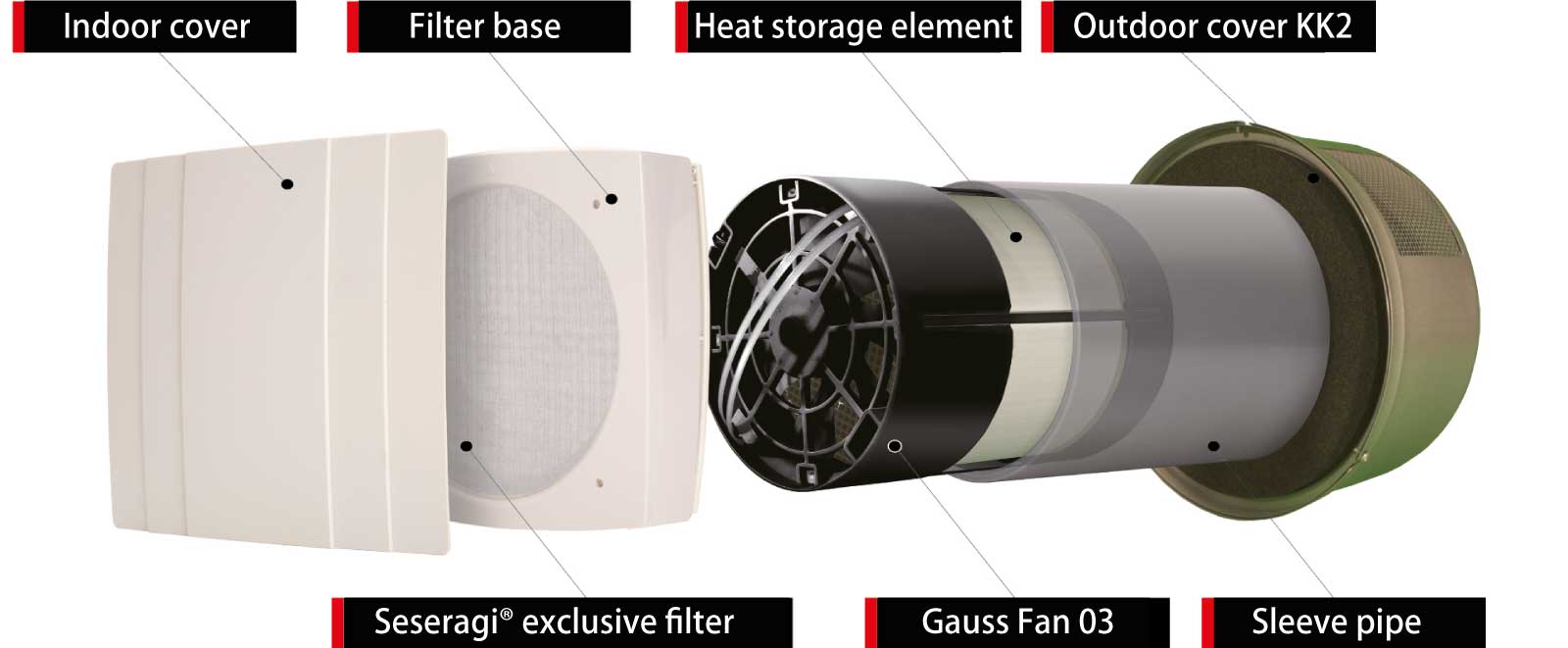

The ductless heat exchange ventilation system switches repeatedly between inflow and outflow by changing the rotation direction of the fan. When exhausting, thermal energy and moisture are preserved in the heat storage element and released indoors when supplying air. Simple maintainability and the ability to easily clean the heat storage element prevent an efficiency decrease due to clogging. This guarantees a stable intake of fresh air.
This animation is not supported in the Internet Explorer.
Please use a supported browser.
*Please turn your phone to landscape view.
70 sec
35 sec
17.5 sec
52.5 sec






In the next 70 second interval, the room is supplied with fresh air, while simultaneously releasing the heat.
During the first 70 second interval, used air is expelled, while heat is retained.

"Seseragi®" ventilation process (heat recovery)
Effects on air conditioning
Winter
Conventional ventilation system

Temperature exchange efficiency 0%
With conventional ventilation systems, cold outside air enters the room unhindered. People increase heating as a countermeasure.
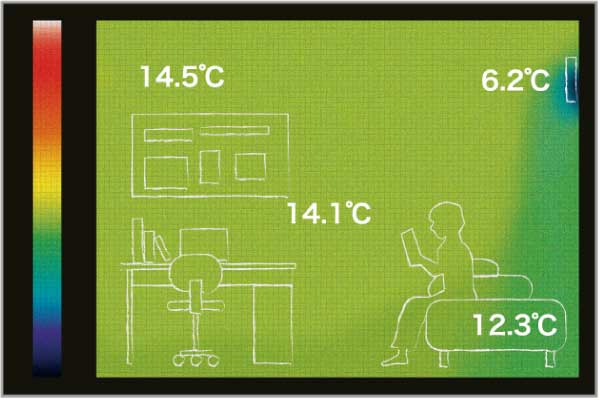
The temperature near the inlet drops to cold 6°C (42.8°F). The room overall is cold at 13°C (55.4°F) and needs to be heated.
"Seseragi®"

Temperature exchange efficiency 93%!
Heat exchange recovers up to 93% of the thermal energy. Air is supplied at close to normal room temperature levels.
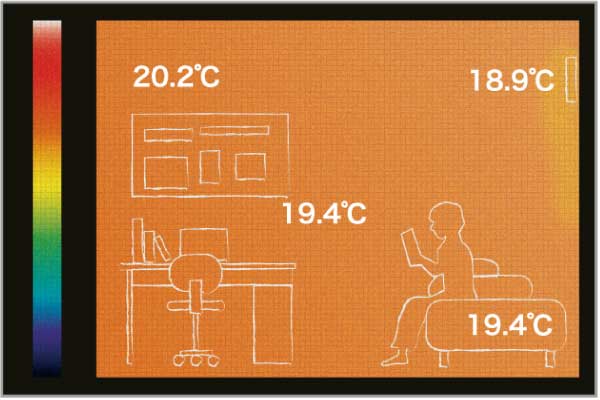
The temperature drop near the air inlet is only ~1°C, while the rest of the room is stable at ~19°C (66.2°F); a comfortable temperature.
Summer
Conventional ventilation system

Temperature exchange efficiency 0%
With conventional ventilation, hot outside air enters the room freely. Only constant air conditioning can regulate the room temperature to comfortable levels.
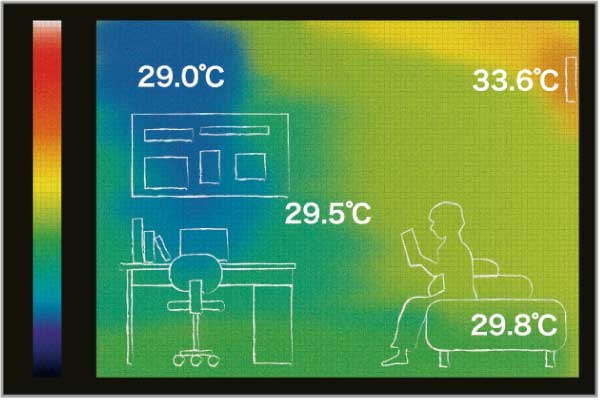
Hot air enters unhindered and the temperature reaches about 33°C (91.4°F) near the air inlet. Most of the room is over 29°C (84.2°F) warm, which necessitates cooling operations.
"Seseragi®"

Temperature exchange efficiency 93%!
With heat exchange technology, ~93% of the air's chilliness can be preserved. Air is supplied at close to comfortable temperature levels.
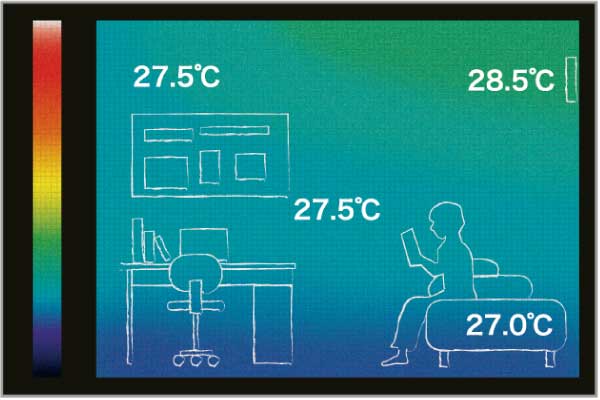
Even near the "Seseragi®", the air is hardly affected by the outside heat and kept at ~29°C (84.2°F). The rest of the room is at ~28°C (82.4°F). Comfortable, if combined with the appropriate humidity.
Effects on humidity
Winter
Conventional ventilation system

Humidity recovery rate 0%
Dry air from the outside dries out the air inside, which can cause skin problems or a cold.
"Seseragi®"

Humidity recovery rate over 80%!
Due to the humidity sensor, the appropriate humidity can be transferred to the inflow of air and thus, reduce the need to humidify.
Summer
Conventional ventilation system

Sticky, hot air enters the room freely, increasing the need to dehumidify.
"Seseragi®"

A sensor enables convenient humidity adjustment.
Utility cost reduction
By installing a heat exchange ventilation system, the loss of internal heat due to ventilation can be minimized, saving power consumed for heating and cooling. It is more power conservative compared to ducted ventilation types, as there is no need to pump air through long ducts, which requires a lot of power. Tempting, that all this can be realized simply by the ductless structure with low air resistance.


◆Conventional ventilation system (Type 3) without heat exchange
In winter for example, when using a conventional ventilation system
without heat exchange,
the energy cost for a single winter will be
about 530$.
◆"Seseragi®" with heat exchange
The "Seseragi®" has a 93% heat exchange
efficiency, so heating costs will be
about 167$,
as 93% of the heat can be recovered.
Therefore, you can
save approximately 68%.
Power consumption analysis

24W
Conventional ventilation
Conventional ventilation is a simple ductless structure, allowing air to flow easily. The efficiency of the AC motor is poor, though. Power consumption is not as high as with central ventilation, but without heat exchange, the cost for air conditioning is significant.

90W
Central ventilation
Centralized heat exchange ventilation have a high strain on their long, complex ducts, as it is necessary to pump air through the whole house with high air resistance. As power required to pump air to each room is high, power consumption increases accordingly.

6.4W
![super energy saving]()
"Seseragi®"
The "Seseragi®" is a combination of a ductless construction with low air resistance and the latest super energy saving DC motor technology. The power consumption is only 6.4 W/h in a 4 unit set. Due to this ultra-low power consumption, the electricity bill will only be ~4.6$ annually.
Reduced energy costs, but higher electricity costs to maintain constant
ventilation...
Does this not diminish the saving effect?
| Model | Power consumption | Annual use time | Electricity charges | Annual electricity bill |
|---|---|---|---|---|
| "Seseragi®" (4 unit set) | 0.0064kW | 8,760h | 0.23$/kWh |
0.0064kWx8760hx0.23$/kWh Normal operation(Air flow level 1)4.35$/year |
| Central ventilation |
90W
(prediction) |
8,760h | 0.23$/kWh |
0.090kWx8760hx0.23$/kWh |
Using the "Night Purge Mode" to cool in summer

In summer, the outside temperature may be lower than inside, such as in the morning or at night. In that case, it is possible to switch to "Night Purge Mode", which replaces the warm inside air directly with fresh outside air to lower the temperature. Switching to this ventilation mode reduces the cooling load of the air conditioner, saving energy.
Energy saving simulation [Hokkaido Asahikawa city]
Simulation setting table
| Part | Thermal insulation specification | Part area A[m²] | Heat penetration coefficient U[W/m²K] | Coefficient H[-] | Heat loss A · U · H [W/K] | Heat loss coefficient Q[W/m²K] |
|---|---|---|---|---|---|---|
| ceiling | Foam polyurethane 300mm | 62.11 | 0.11 | 1.0 | 6.865 | 0.049 |
| Outer wall | GW16K 105mm + EPS board 50mm | 110.59 | 0.27 | 1.0 | 29.599 | 0.210 |
| Outer Wall B | GW16K 105mm + EPS board 50mm | 0.00 | 0.27 | 1.0 | 0.000 | 0.000 |
| Floor area | GW16K 25mm + EPS board 50mm | 23.88 | 0.32 | 1.0 | 7.678 | 0.055 |
| Floor area B | GW16K 25mm + EPS board 50mm | 0.00 | 0.32 | 1.0 | 0.000 | 0.000 |
| Floor | Rigid urethane foam 120mm | 54.26 | 0.27 | 0.7 | 10.376 | 0.074 |
| Floor B | HGW16K 180mm | 62.11 | 0.26 | 0.7 | 11.164 | 0.079 |
| Foundation | EPS board 75mm | - | - | 1.0 | 33.212 | 0.236 |
| Foundation B | EPS board 75mm | - | - | 1.0 | 0.000 | 0.000 |
| Aperture | - | 40.25 | - | 1.0 | 187.148 | 1.329 |
| Ventilation | Ventilation frequency 0.5 times(93%heat exchange ventilation) | 338.14 | - | 1.0 | 15.181 | 0.108 |
| Considerable floor space | - | 140.82 | - | 1.0 | - | - |
| Whole house | 301.223 | 2.139 | ||||
Simulation result table (in case of conventional ventilation)
| 0 | Whole house | Per 1 m² |
|---|---|---|
| Heat loss coefficient[W/K] | 345.21 | 2.45 |
| Summer solar radiation acquisition coefficient[-] | 19.195 | 0.075 |
| Annual heating/cooling energy consumption | Heating | Cooling | Total heating and cooling | |||
|---|---|---|---|---|---|---|
| Whole house | Per 1 m² | Whole house | Per 1 m² | Whole house | Per 1 m² | |
| Heat amount[kWh] | 25,624 | 182.0 | 142 | 1.0 | 25,766 | 183.0 |
| Electricity consumption[kWh/㎡] | 10,249 | 72.8 | 28 | 0.2 | 10,278* | 73.0 |
| CO² generated[kg] | 4,909 | 34.9 | 4923.1 | 35.0 | 9833 | 69.8 |
*Annual power consumption per 1 m² of space
Simulation result table (when using the "Seseragi®")
| 0 | Whole house | Per 1 m² |
|---|---|---|
| Heat loss coefficient[W/K] | 301.22 | 2.14 |
| Summer solar radiation acquisition coefficient[-] | 19.195 | 0.075 |
| Annual heating/cooling energy consumption | Heating | Cooling | Total heating and cooling | |||
|---|---|---|---|---|---|---|
| Whole house | Per 1 m² | Whole house | Per 1 m² | Whole house | Per 1 m² | |
| Heat amount[kWh] | 20,724 | 147.2 | 334 | 2.4 | 21,057 | 149.5 |
| Electricity consumption[kWh/m²] | 8,289 | 58.9 | 67 | 0.5 | 8,356* | 59.3 |
| CO² generated[kg] | 3,971 | 28.2 | 4002.6 | 28.4 | 7973 | 56.6 |
*Annual power consumption per 1 m² of space
The simulation of the Seseragi's effects on energy saving resulted
in a total saving of
1,922 kWh/m² of
electricity consumption per square meter of space.
Monthly simulation graphs
Conventional ventilation

| 0 | January | February | March | April | May | June | July | August | September | October | November | December | Total |
|---|---|---|---|---|---|---|---|---|---|---|---|---|---|
| Heating DD[°C・day] | 641.66 | 559.63 | 464.02 | 255.34 | 94.33 | 25.14 | 3.06 | 1.80 | 20.89 | 134.33 | 324.34 | 568.16 | 3092.71 |
| Percentage of each month[%] | 20.75 | 18.10 | 15.00 | 8.26 | 3.05 | 0.81 | 0.10 | 0.06 | 0.68 | 4.34 | 10.49 | 18.37 | 100.00 |
| Cooling DD[°C・day] | 0.00 | 0.00 | 0.00 | 0.00 | 0.00 | 3.20 | 9.21 | 2.09 | 0.00 | 0.00 | 0.00 | 0.00 | 14.50 |
| Percentage of each Month[%] | 0.00 | 0.00 | 0.00 | 0.00 | 0.00 | 22.07 | 63.52 | 14.41 | 0.00 | 0.00 | 0.00 | 0.00 | 100.00 |
| Oil consumption[ℓ] | 607.9 | 530.2 | 439.6 | 241.9 | 89.4 | 23.8 | 2.9 | 1.7 | 19.8 | 127.3 | 307.3 | 538.2 | 2929.9 |
| Heating energy[kWh] | 5316.3 | 4636.6 | 3844.5 | 2115.5 | 781.5 | 208.3 | 25.3 | 14.9 | 173.1 | 1113.0 | 2687.2 | 4707.3 | 25623.6 |
| Cooling energy[kWh] | 0.0 | 0.0 | 0.0 | 0.0 | 0.0 | 41.3 | 119.0 | 27.0 | 0.0 | 0.0 | 0.0 | 0.0 | 187.3 |
January energy
consumption: 5316 kWh
"Seseragi®"

| 0 | January | February | March | April | May | June | July | August | September | October | November | December | Total |
|---|---|---|---|---|---|---|---|---|---|---|---|---|---|
| Heating DD[°C・day] | 612.90 | 533.64 | 435.17 | 228.25 | 76.24 | 17.90 | 1.56 | 0.67 | 13.01 | 111.09 | 296.76 | 539.40 | 2866.59 |
| Percentage of each month[%] | 21.38 | 18.62 | 15.18 | 7.96 | 2.66 | 0.62 | 0.05 | 0.02 | 0.45 | 3.88 | 10.35 | 18.82 | 100.00 |
| Cooling DD[°C・day] | 0.00 | 0.00 | 0.00 | 0.00 | 0.00 | 7.94 | 17.41 | 9.96 | 0.86 | 0.00 | 0.00 | 0.00 | 36.17 |
| Percentage of each month[%] | 0.00 | 0.00 | 0.00 | 0.00 | 0.00 | 21.95 | 48.13 | 27.54 | 2.38 | 0.00 | 0.00 | 0.00 | 100.00 |
| Oil consumption[ℓ] | 506.6 | 441.1 | 359.7 | 188.7 | 63.0 | 14.8 | 1.3 | 0.5 | 10.8 | 91.8 | 245.3 | 445.9 | 2369.6 |
| Heating energy[kWh] | 4430.9 | 3857.9 | 3146.0 | 1650.1 | 551.2 | 129.4 | 11.3 | 4.8 | 94.1 | 803.1 | 2145.4 | 3899.5 | 20723.6 |
| Cooling energy[kWh] | 0.0 | 0.0 | 0.0 | 0.0 | 0.0 | 74.4 | 163.1 | 93.3 | 8.1 | 0.0 | 0.0 | 0.0 | 338.8 |
January energy
consumption: 4430 kWh
Annual savings with the "Seseragi®"
It can be seen that the energy saving effect of the "Seseragi®"
saves about 20% when
considering heating and electricity costs.
Electricity savings
difference
-998.47$

Heating /
Electricity bill
[0.2$/1kWh]

Energy saving simulation [Tokyo]
Simulation setting table (in case of conventional ventilation)
| Part | Thermal insulation specification | Part area A[m²] | Heat penetration coefficient U[W/m²K] | Coefficient H[-] | Heat loss A・U・H・[W/K] | Heat loss coefficient Q[W/m²K] |
|---|---|---|---|---|---|---|
| Ceiling | High performance phenolic foam 200 mm | 47.67 | 0.11 | 1.0 | 5.118 | 0.052 |
| Outer wall | High performance phenolic foam 90 & 45 mm | 143.22 | 0.27 | 1.0 | 38.666 | 0.395 |
| Floor area | High performance phenolic foam 25 & 45 mm | 9.18 | 0.27 | 1.0 | 2.497 | 0.026 |
| Foundation | High performance phenolic foam 100 mm | - | - | 1.0 | 21.698 | 0.222 |
| Aperture | - | 35.90 | - | 1.0 | 24.442 | 0.250 |
| Ventilation | Ventilation frequency 0.6 times | 282.36 | - | 1.0 | 59.296 | 0.607* |
| Considerable floor space | - | 97.77 | - | 1.0 | - | - |
| Whole house | 151.717 | 1.552 | ||||
*Heat loss coefficient in ventilation
| Annual heating/cooling energy consumption | Heating | Cooling | Total heating and cooling | |||
|---|---|---|---|---|---|---|
| Whole house | Per 1 m² | Whole house | Per 1 m² | Whole house | Per 1 m² | |
| heating amount[kWh] | 7301.2 | 74.7 | 4816.7 | 49.3 | 12117.9 | 124.0 |
| Electricity consumption[kWh/m²] | 3650.6 | 37.4 | 1605.6 | 16.4 | 5256.2* | 53.8 |
| CO² generated[kg] | 1233.9 | 12.6 | 542.7 | 5.6 | 1776.5 | 18.2 |
*Total annual power consumption per 1 m² of space
Simulation setting and result tables (when using "Seseragi®")
| Part | Thermal insulation specification | Part area A[m²] | Heat penetration coefficient U[W/m²K] | Coefficient H[-] | Heat loss A・U・H・[W/K] | Heat loss coefficient Q[W/m²K] |
|---|---|---|---|---|---|---|
| Ceiling | High performance phenolic foam 200 mm | 47.67 | 0.11 | 1.0 | 5.118 | 0.052 |
| Outer wall | High performance phenolic foam 90 & 45 mm | 143.22 | 0.27 | 1.0 | 38.666 | 0.395 |
| Floor area | High performance phenolic foam 25 & 45 mm | 9.18 | 0.27 | 1.0 | 2.497 | 0.026 |
| Foundation | High performance phenolic foam 100 mm | - | - | 1.0 | 21.698 | 0.222 |
| Aperture | - | 35.90 | - | 1.0 | 24.442 | 0.250 |
| Ventilation | Ventilation frequency 0.6 times | 282.36 | - | 1.0 | 59.296 | 0.150* |
| Considerable floor space | - | 97.77 | - | 1.0 | - | - |
| Whole house | 151.717 | 1.552 | ||||
*Heat loss coefficient 0.45 W/m²K reduction
| Annual heating/cooling energy consumption | Heating | Cooling | Total heating and cooling | |||
|---|---|---|---|---|---|---|
| Whole house | Per 1 m² | Whole house | Per 1 m² | Whole house | Per 1 m² | |
| Heating amount[kWh] | 4068.7 | 41.6 | 1994.5 | 20.4 | 6063.2 | 62.0 |
| Electricity consumption[kWh/m²] | 2034.4 | 20.8 | 664.8 | 6.8 | 2699.2* | 27.6 |
| CO² generated[kg] | 687.6 | 7.0 | 224.7 | 2.3 | 912.3 | 9.3 |
*Total annual power consumption per 1 m² of space
The energy saving effects simulation of "Seseragi®" resulted in a total saving
of
2,557 kWh/m² of
electricity consumption per square meter of space.
Besides costs for heating, Tokyo also has a lot of cooling costs!!
Monthly simulation
Conventional ventilation

| 0 | January | February | March | April | May | June | July | August | September | October | November | December | Total |
|---|---|---|---|---|---|---|---|---|---|---|---|---|---|
| Heating DD[°C・day] | 265.79 | 237.54 | 149.99 | 44.56 | 6.41 | 0.04 | 0.00 | 0.00 | 0.00 | 7.39 | 76.08 | 183.37 | 971.17 |
| Percentage of each month[%] | 27.37 | 24.46 | 15.44 | 4.59 | 0.66 | 0.00 | 0.00 | 0.00 | 0.00 | 0.76 | 7.83 | 18.88 | 100.00 |
| Cooling DD[°C・day] | 0.00 | 0.00 | 0.00 | 2.17 | 23.52 | 62.99 | 173.45 | 194.22 | 114.88 | 14.64 | 0.28 | 0.00 | 585.95 |
| Percentage of each month[%] | 0.00 | 0.00 | 0.00 | 0.37 | 4.01 | 10.75 | 29.90 | 33.15 | 19.60 | 2.50 | 0.05 | 0.00 | 100.00 |
| Oil consumption[ℓ] | 228.5 | 204.2 | 128.9 | 38.3 | 5.5 | 0.0 | 0.0 | 0.0 | 0.0 | 6.4 | 65.4 | 157.6 | 834.8 |
| Heating energy[kWh] | 1998.2 | 1785.8 | 1127.6 | 335.0 | 48.2 | 0.3 | 0.0 | 0.0 | 0.0 | 55.5 | 572.0 | 1378.6 | 7301.2 |
| Cooling energy[kWh] | 0.0 | 0.0 | 0.0 | 17.9 | 193.2 | 517.6 | 1425.4 | 1596.0 | 944.0 | 120.3 | 2.3 | 0.0 | 4816.7 |
January energy
consumption: 1998 kWh
"Seseragi®"

| 0 | January | February | March | April | May | June | July | August | September | October | November | December | Total |
|---|---|---|---|---|---|---|---|---|---|---|---|---|---|
| Heating DD[°C・day] | 296.47 | 265.11 | 176.53 | 56.43 | 8.68 | 0.06 | 0.00 | 0.00 | 0.00 | 10.17 | 92.55 | 211.40 | 1117.41 |
| Percentage of each month[%] | 26.53 | 23.73 | 15.80 | 5.05 | 0.78 | 0.01 | 0.00 | 0.00 | 0.00 | 0.91 | 8.28 | 18.92 | 100.00 |
| Cooling DD[°C・day] | 0.00 | 0.00 | 0.00 | 0.00 | 11.4 | 42.00 | 140.83 | 159.70 | 87.70 | 5.08 | 0.00 | 0.00 | 14.50 |
| Percentage of each month[%] | 0.00 | 0.00 | 0.00 | 0.00 | 2.57 | 9.47 | 31.76 | 36.02 | 19.78 | 1.15 | 0.00 | 0.00 | 100.00 |
| Oil consumption[ℓ] | 123.4 | 110.4 | 73.5 | 23.5 | 3.6 | 0.0 | 0.0 | 0.0 | 0.0 | 4.2 | 38.5 | 88.0 | 465.2 |
| Heating energy[kWh] | 1079.5 | 965.3 | 642.8 | 205.5 | 31.6 | 0.2 | 0.0 | 0.0 | 0.0 | 37.0 | 337.0 | 769.8 | 4068.7 |
| Cooling energy[kWh] | 0.0 | 0.0 | 0.0 | 0.0 | 50.9 | 187.5 | 628.8 | 713.1 | 391.6 | 22.7 | 0.0 | 0.0 | 1994.5 |
January energy
consumption: 1079 kWh
Annual savings with the "Seseragi®"
It can be seen that the energy saving effect of the "Seseragi®"
saves about 50% when
considering heating and electricity costs.
Electricity savings
difference
-1,239$

Heating /
Electricity bill
[0.2$/1kWh]

Heat storage element analysis
Seseragi's heat storage element

【semi-permanent】Ceramic heat storage element

Due to the alternating fan rotation feature of the "Seseragi®", the temperature difference between the heat storage element and the air passing through the inside is 2 to 3°C or less. This temperature difference is too small to reach the dew point. Thus, condensation does not occur.
Heat storage element of a duct type heat exchange ventilation system
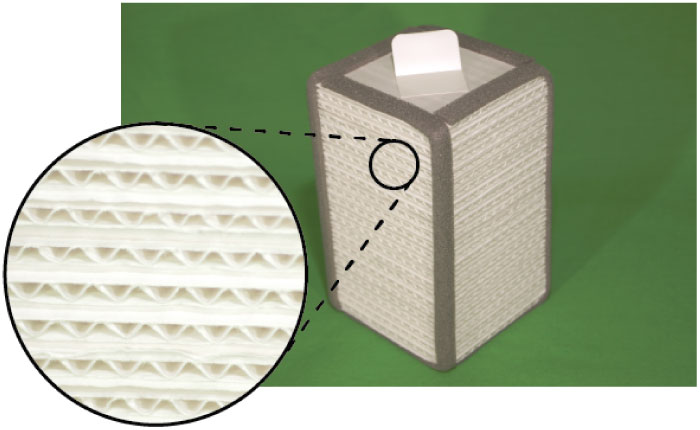

【Consumable】Paper heat exchange element
In case of a duct type heat exchange ventilation system, the heat storage element is like a cardboard; a multilayered, thin paper structure. Flowing air passes through each layer, where it gets sandwiched to exchange temperature and humidity.
At that time, since the indoor air and the outdoor air directly intersect, a large temperature difference occurs. The warm air cools down rapidly, falls below the dew point and condensation occurs.
Condensation occurs because air with a temperature difference of 20°C (36°F) intermingles.
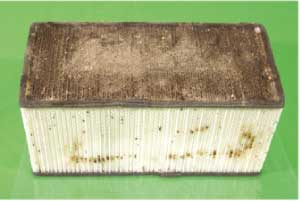
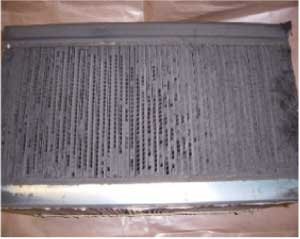
Dirt, such as dust is easily clogged in the cardboard due to its grooved structure. Following the temperature difference, condensation occurs. When that happens, mold forms. Since the material is paper, mold is likely to spread.
Sanitary problems in ducted heat exchange ventilation systems
"Seseragi®"

The "Seseragi®" is installed separately and does not pump impure air through the whole house.
Duct heat exchange ventilation

With the central heat exchange ventilation system, all air passes through the heat storage element. Used air that has circulated through the whole house, including the toilet and bathroom, intersects with the fresh air.
Image and figure

Microscope magnification


 heat
heat
 humidity
humidity
 dirt
dirt
 odor
odor
Water vapor and impure air, contaminated by toilet odor,
VOC and CO2, will return
to the room with the inflowing air
through the paper filter. Some air is leaked between the air
supply and exhaust. The heat exchange efficiency
correction factor indicates a 10% leakage in most products (correction
factor of 0.9).
Maintenance
Designed for easy maintainability

Comfortable and clean ventilation requires regular maintenance. The
"Seseragi®" is designed with priority on easy
maintenance
to minimize the burden on the client. Thus, it can achieve highly
hygienic and economical heat exchange ventilation.

The "Seseragi®" is mounted on a wall for handy component removal.
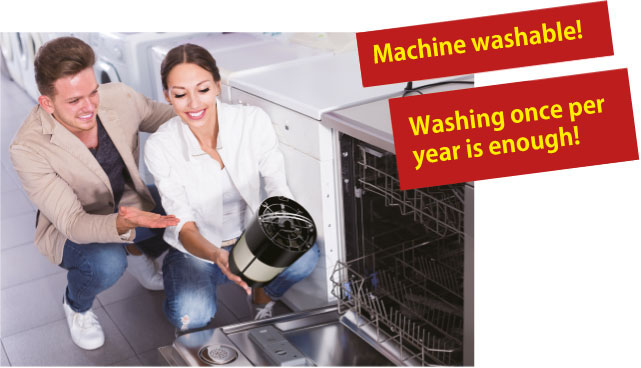
The new "Gauss Fan 03" fan unit of the "Seseragi®" is completely waterproof (IP 68
compliant). Not only the ceramic
storage element but also the fan are fully washable.
Do not wash above 40°C

In the case of duct type ventilation system, maintenance of the
ceiling duct can only be done by a specialist.
When replacing the filter, mold and dust still remain inside the duct
and on the fan blades. This causes polluted air to circulate from room
to room, resulting in a hygienic problem.
Maintenance is a burden on health and finance.

Duct type ventilation: inside view of a duct
Dust and mold are accumulating on the inside of the duct and on the fan blades. The heat exchange element is relatively easy to replace, but the ducts and the small fan blades can not be cleaned so easily. Even if the heat exchange element is replaced, mold still remains in the duct, which will never return to its original clean state.
Air freshener・Pollen・PM2.5
"Seseragi®"

The "Seseragi®" is equipped with a high-performance filter that cuts 98% of pollen. Thanks to the fine texture, that does not even allow pollen to pass, dust and mold spores in the air are also intercepted.
Conventional ventilation

Conventional ventilation systems have a coarse filter, allowing pollen and dust to enter.
High-performance filter to remove pollen and PM2.5
We equipped the "Seseragi®" with an air freshening
filter, which removes 98% of fine pollen. This filter has a two-layer
structure,
cleaning the air in two steps: first, dust particles are taken out of
the air by a medium-performance filter. The 2nd layer then removes
pollen particles with a high-performance filter. As a result, the
durability of the high-performance filter has been significantly
improved,
and the amount of pollen,
PM2.5 and other
particles that enter the house can be greatly reduced to maintain a
clean, healthy environment.
◆Typical dust particles

Dust

Pollen

Mold spores

Pet fur

Mite corpses and waste

PM2.5
Removal of over 99% of harmful substances
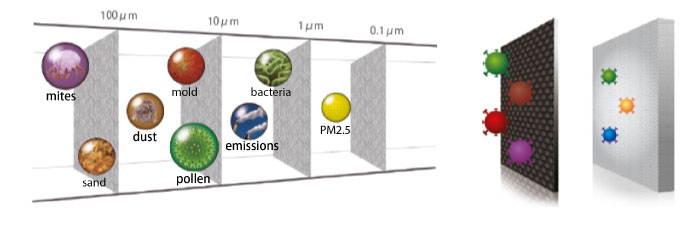
Seseragi®'s high-performance filters
New design since May 2019
◆Virus sterilization filter
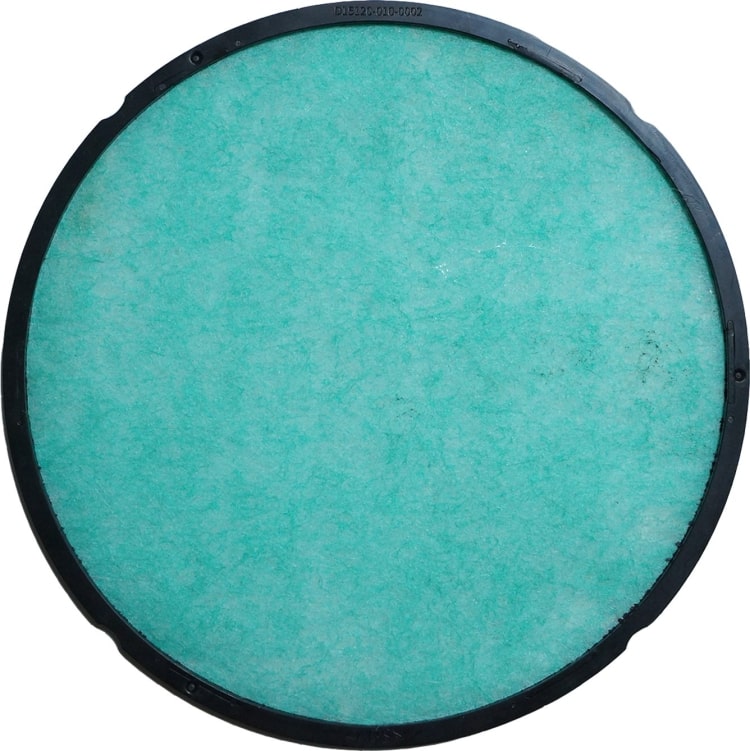
Protects against

dust

pollen

mold spores

tick carcasses and feces

Pet fur
virus
◆Virus sterilization filter + PM2.5
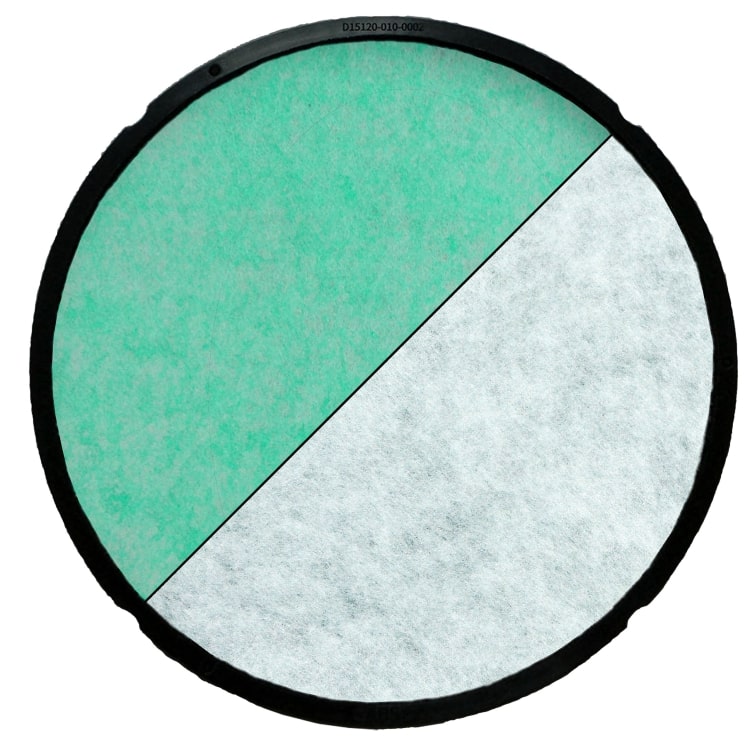
Protection against

dust

pollen high efficiency

mold spores

tick carcasses and feces

Pet fur

PM2.5
virus
The virus sterilization filter is a product of Nikki-Universal Co.,
Ltd.
For more information
https://www.n-u.co.jp/jp/products/enzymefilter/
◆PM2.5・Pollen filter
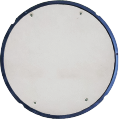
Protection against

dust

pollen

mold spores

mite corpses and waste

pet fur

PM2.5
◆Standard filter included
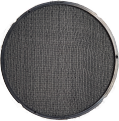
Protection against

dust
Previous versions
◆Deodorization filter
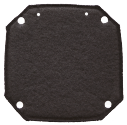
Protection against

dust

pollen

mold spores

mite corpses and waste

pet fur

bacteria

fumes
◆PM2.5・Pollen filter

Protection against

dust

pollen

mold spores

mite corpses and waste

pet fur

PM2.5
◆Antibacterial filter

Protection against

dust

pollen

mold spores

mite corpses and waste

pet fur

bacteria
◆Standard filter included

Protection against

dust
Shop
You can choose the most suitable filter according to your residential environment.
More space at home
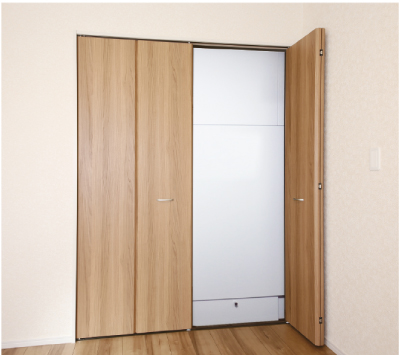
Duct type systems reduce storage space
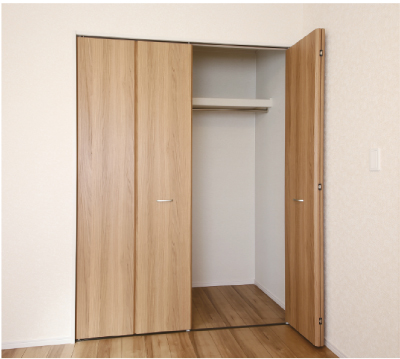
When using the "Seseragi®", storage space can be freed up!
The duct type ventilation system takes up a lot of installation space. Moreover, it requires high power to ventilate each room, resulting in additional restrictions regarding the place of installation. You can't set it up in the bedroom. You see that space is not the only factor when planning the design of a house. The ductless "Seseragi®" will not bother you with the installation location. Ideal for narrow houses and renovations.
"Seseragi®" lineup
Fan unit
Gauss Fan GF03
Heat exchange efficiency
93%
Air flow
(turbo function)
80 m³/h
power consumption
(MAX)
1.6W/h
Specific power consumption
0.04 W/m³・h
Electricity charges per unit
(1 kWh = 0.25$)
1.32$
Heat storage element
Honeycomb
cartridge type
Heat storage element diameter
150 ⌀
Heat storage element length
150 mm
Corresponding outer wall thickness
(KK2d)
110 ~ 380 mm
Outer sleeve tube shape
165 mm
Sleeve length
400 mm

 日本語
日本語
 Deutsch
Deutsch
 English
English
 한국어
한국어
 Français
Français
